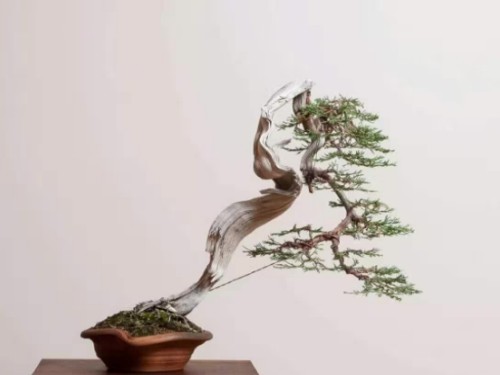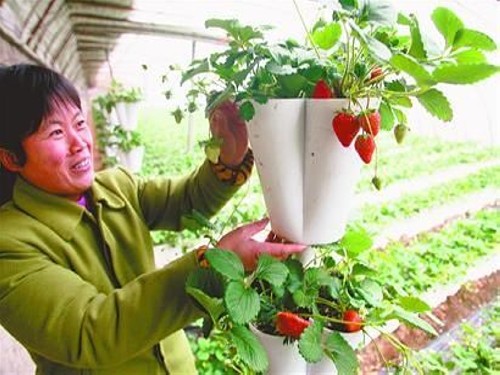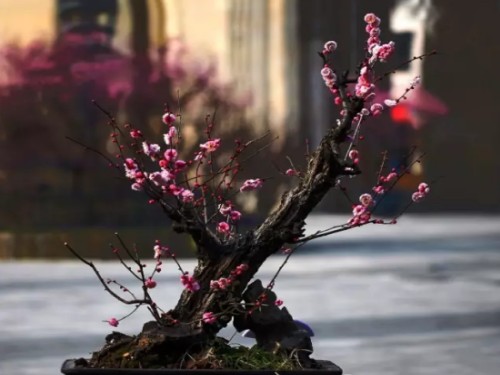Bonsai cultivation techniques of Sabina vulgaris
Sabina vulgaris is a very beautiful ornamental plant. Sabina vulgaris is a positive plant, this kind of tree is more shade-tolerant plants, we must choose a relatively dry soil when planting Sabina vulgaris. It is not easy to grow in acidic soil and saline soil, and the requirement of juniper is relatively high above the temperature. When the temperature reaches 32 degrees Celsius, the tree stops growing, and when it is minus 10 degrees Celsius, it will die for ten days.
Many people not only like the juniper bracelet, but also want to get a bonsai. Sabina vulgaris is a prehistoric plant, originated more than 300 million years ago, is a Cretaceous relict plant in the dinosaur era, known as the world's rarest and oldest gymnosperms, is an extremely rare only living plant fossil in the world. In the process of digging the cypress, the brothers in the mountains often dig up some live materials, and there are also special materials to be used to make bonsai. If you want to plant a live cypress, you must master the following links.

1. Draw materials
Looking for scenery piles in the mountains, there should be poetic and picturesque feelings in your heart, with many beautiful artistic images, artistic postures, artistic combinations and exaggerated and fixed artistic lines in your eyes. Sabina vulgaris sprouts many times a year and can be mined in spring, summer, autumn and winter. But preferably after hibernation, March and April of each year can be regarded as the golden season. The root is the least suitable to dig, but as long as there are two or three small red roots, there is also hope of survival, the more leaves, the better. Having roots and leaves is the first root for the survival of the cypress. If there are no roots and leaves, no matter how hard you try, it is futile.
2. Processing
The operation should be slow and detailed. The size of the soil ball is determined according to the thickness of the base. Cut the root when you see the root, and the mouth of the thick root should be flat so as not to break the skin. Dug earth balls to strictly prevent air-drying, should first be tied with wet grass or fresh cypress leaves, tightly wrapped before being transported. The harvested Sabina vulgaris plants had better go to the mud basin first, the large ones are planted in the soil bed above the ground, the bottom is covered with river sand, and the sandy loess with slightly alkaline loess and sandy loess with Xiangyang cliff water is the best.
3. Using soil
Cultivation soil must be permeable, breathable, loose mixed soil, do not use pure soil, generally add 80% of the river sand. In the area of Taihang Mountain, it is best to use the coal ball which has no fire gas for a period of time after burning. The waste coal ball ash is aseptic, permeable and breathable, and has good moisturizing properties, which is very suitable for the cultivation of Sabina vulgaris. When watering, the water must seep into the soil within 2 or 3 seconds and flow out of the basin bottom.
4. Watering
After the Sabina vulgaris plants are put into the pot, the water should be strictly controlled. Cypress belongs to yin and pine belongs to yang. The so-called "dry pine and wet cypress", generally speaking, the newly planted cypress is particularly afraid of waterlogging, waterlogging will rot the root and die. Water control means less watering and more spraying, basin surface does not have stagnant water, it is better to see wet and dry every day. Newly planted Sabina vulgaris had better be cultivated in greenhouse, which is the best way to improve the survival rate, which can keep moisture and control temperature. The basin soil can not be dry during the growing period, and it is best to keep the humidity in the environment above 70%. The main purpose of moisturizing and temperature control is to keep the trunk and leaves from losing water, maintain life, and continue to take root and sprout.
5. Lighting
The new tree of Sabina vulgaris has very few roots, and the function of absorbing water is already very weak. at this time, the leaves can breathe and absorb water on the leaf surface, maintain life and carry out photosynthesis, which in turn promotes the flow of sap, promotes root survival, and germinates new roots. so it's useful for new trees to bring more leaves. In the growing period of appropriate temperature and humidity, enough light, the leaf photosynthesis is strong, more conducive to survival. But in midsummer, if the light is too strong, it will not be able to maintain the humidity of the growth environment, and it will also evaporate the original water in the new tree body and dry the tree body, so it is necessary to properly shade and use a sunshade net with low shading rate, but it can not be shaded for a long time.
6. Planting
The shorter the time from picking and digging from the cliff to the soil, the better, and the living trees should be planted that night after going down the hill. If you don't plant at that time, you can put it in a warm, humid dark place, keep it moist with sprinkling water and spray, and don't soak the roots in water. After planting, it is best not to transplant within three years, and never transplant twice within one year. It is difficult for a cypress to take root, and the roots of a tree that has survived for two years may not necessarily grow well, so it has to be planted in a container, and after planting, the trunk is fixed on the container with a rope so that the tree cannot shake.
7. Pest control
Almost 100% of the new trees planted by Sabina vulgaris will have insect pests. Dead trees on the cliff will not get worms, but down the mountain, dead trees and living trees will be infested with worms, which are called bark beetles. It only lives in the white cortex of the cliff cypress and does not enter the heart of the tree. When wormholes are found in the tree, the tree is actually hopeless. Because only when the sap does not flow and the hydraulic pressure is low can the bark beetle get in and bite the tree trunk. Therefore, as soon as the tree is planted, it is necessary to spray or brush the trunk for defense. Use 100 times dichlorvos, dichlorvos is easy to hurt leaves, so do not spray on twigs and leaves. Spray the trunk several times during the first year of cultivation, especially during the growing period and when the temperature is high.
After the survival of the juniper pile, at least after a year or two or more careful maintenance, the top branches will be prosperous, the lateral branches will be strong, the leaves will be fat, and the branches and roots will make it luxuriant before it can be tied and pulled. Cliff cypress landscape must respect the tree nature of the cliff cypress, most of the trunk is twisted, clumsy and strange, with four different roots, entering the ground, foliage clusters, tree crowns or clouds and rain, or peaks and mountains, mostly triangles and unequilateral triangles.
Time: 2019-05-24 Click:
- Prev

What are organic strawberries? Planting techniques of potted organic strawberries
What are organic strawberries?
- Next

Cultivation techniques of red plum bonsai
Red plum is a kind of flower, a kind of pure and beautiful flower. Cold earth, it tenaciously blossoms beautiful, pure and thin flowers, some white through red, some white and elegant, and some pink such as Xia petals moist and transparent, like ice carvings, if jade. It is varied, brilliant and fragrant, fluttering with the wind
Related
- Fuxing push coffee new agricultural production and marketing class: lack of small-scale processing plants
- Jujube rice field leisure farm deep ploughing Yilan for five years to create a space for organic food and play
- Nongyu Farm-A trial of organic papaya for brave women with advanced technology
- Four points for attention in the prevention and control of diseases and insect pests of edible fungi
- How to add nutrient solution to Edible Fungi
- Is there any good way to control edible fungus mites?
- Open Inoculation Technology of Edible Fungi
- Is there any clever way to use fertilizer for edible fungus in winter?
- What agents are used to kill the pathogens of edible fungi in the mushroom shed?
- Rapid drying of Edible Fungi

